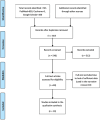Daily versus intermittent iron supplementation among children with iron deficiency anemia: A meta-analysis
- PMID: 39634908
- PMCID: PMC11613373
- DOI: 10.12669/pjms.40.11.10344
Daily versus intermittent iron supplementation among children with iron deficiency anemia: A meta-analysis
Abstract
Objective: This meta-analysis aimed to investigate daily versus intermittent iron supplementation among children.
Methods: The author searched the Cochrane Library, PubMed, Medline, and Google Scholar for randomized controlled trials and compared daily versus intermittent iron supplementation. The keywords iron deficiency anemia, iron therapy, daily, twice per week, and once weekly were used. The search was limited to the period January 2012 up to November 2023. The age of participant range from two months to 18 years.
Result: Out of the 735 studies, 540 were eligible after removal of duplication, of them, 28 full texts were screened and only 10 studies were included. Daily iron supplementation was better in improving hemoglobin odd ratio, 0.41, 95 CI, 0.38-0.44, Z=26.53, and p-Value <0.001 than intermittent prescription odd ratio, 0.69, 95 CI, 0.67-0.72, Z=49.98, and P-value < 0.001.
Conclusion: Daily supplementation increased hemoglobin more compared to weekly or twice/week among children with iron deficiency anemia. Further larger studies assessing tolerance and compliance are needed.
Keywords: Children; Daily; Intermittent; Iron deficiency anemia; Iron supplementation.
Copyright: © Pakistan Journal of Medical Sciences.
Conflict of interest statement
Conflicts of Interest: None.
Figures
Similar articles
-
Intermittent iron supplementation for reducing anaemia and its associated impairments in adolescent and adult menstruating women.Cochrane Database Syst Rev. 2019 Jan 31;1(1):CD009218. doi: 10.1002/14651858.CD009218.pub3. Cochrane Database Syst Rev. 2019. PMID: 30699468 Free PMC article.
-
Effectiveness of intermittent iron treatment of two- to six-year-old Jordanian children with iron-deficiency anemia.Food Nutr Bull. 2006 Sep;27(3):220-7. doi: 10.1177/156482650602700304. Food Nutr Bull. 2006. PMID: 17542112 Clinical Trial.
-
Efficacy of daily versus intermittent oral iron supplementation for prevention of anaemia among pregnant women: a systematic review and meta-analysis.EClinicalMedicine. 2024 Jul 17;74:102742. doi: 10.1016/j.eclinm.2024.102742. eCollection 2024 Aug. EClinicalMedicine. 2024. PMID: 39114275 Free PMC article.
-
Home fortification of foods with multiple micronutrient powders for health and nutrition in children under two years of age (Review).Evid Based Child Health. 2013 Jan;8(1):112-201. doi: 10.1002/ebch.1895. Evid Based Child Health. 2013. PMID: 23878126 Review.
-
Daily iron supplementation is more efficacious than twice weekly iron supplementation for the treatment of childhood anemia in western Kenya.J Nutr. 2004 May;134(5):1167-74. doi: 10.1093/jn/134.5.1167. J Nutr. 2004. PMID: 15113965 Clinical Trial.
References
-
- Lopez A, Cacoub P, Macdougall IC, Biroulet PL. Iron deficiency anaemia. Lancet. 2016;387:907–916. doi:10.1016/S0140-6736(15)60865-0. - PubMed
-
- Sundararajan S, Rabe H. Prevention of iron deficiency anemia in infants and toddlers. Pediatr Res. 2021;89:63–73. doi:10.1038/s41390-020-0907-5. - PubMed
-
- Walter T. Effect of iron-deficiency anemia on cognitive skills and neuromaturation in infancy and childhood. Food Nutr Bull. 2003;24(4 Suppl):S104–S110. doi:10.1177/15648265030244S207. - PubMed
LinkOut - more resources
Full Text Sources



